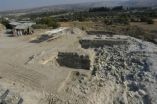(Press-News.org) A recent find by a University of Cincinnati archeologist suggests an ancient Mycenaean city was well protected from outside threats.
That research, by UC's Gisela Walberg, professor of classics, will be presented at the annual workshop of the Cyprus American Archaeological Research Center in Nicosia, Cyprus, on June 25, 2011.
Since 2001, Walberg has worked in modern Cyprus to uncover the ancient city of Bamboula, a Bronze Age city that was an important trading center for the Middle East, Egypt and Greece. Bamboula, a harbor town that flourished between the 13th through the 11th century B.C., sits along a highway on the outskirts of the modern village of Episkopi, along the southwestern coast of Cyprus and near the modern harbor town of Limassol. The area thrived in part because the overshadowing Troodos Mountains contained copper, and the river below was used to transport the mined materials.
Her most recent research at the site revealed the remnants of a Late Bronze Age (1500-750 B.C.) fortress that may have functioned to protect the urban economic center further inland, which does not seem to have been fortified.
Clues to the function of the structure were clear to Walberg. "It's quite clear that it is a fortress because of the widths and strengths of the walls. No house wall from that period would have that strength. That would have been totally unnecessary," she said, noting that one wall is 4.80 meters thick. "And it is on a separate plateau, which has a wonderful location you can look north to the mountains or over the river, and you can see the Mediterranean to the south -- so you can see whoever is approaching."
"We found the first walls, which we thought were interesting, in 2005," Walberg said. "But, we continued, and this year, we found a staircase – actually we had found two steps before of a similar staircase, but this time we found a whole staircase."
According to Walberg, the staircase seems to have been broken in a violent catastrophe, which throws lights on the early Late Bronze Age history in Cyprus, a period of which little is known but characterized by major social upheaval and cemeteries containing what a number of scholars have identified as mass burials.
The recent find is also particularly significant because there is another older site from the Middle Bronze Age nearby, within walking distance, of the fortress. Upriver exists remains of a large economic center, called Alassa, a center for trading agricultural products and metal.
"Our find, the fortress, fills the gap in time in between this early settlement and the very big, important economic center. It probably was the center, the core, from which urbanization began in the area," Walberg said.
INFORMATION:
Walberg is currently the Marion Rawson Professor of Aegean Prehistory in the Department of Classics at the University of Cincinnati. Her fieldwork experience includes participation in excavations in Sweden, Crete and Cyprus. She has also participated in archaeological surveys in Greece and Italy.
Walberg's published works include 10 books and monographs. One is a report on the 1985-1991 excavations at Midea. She has also authored 81 articles and 20 reviews in American and international archaeological periodicals and lectured in many countries. Currently, Walberg is working on a book about the Bamboula excavations.
UC research uncovers ancient Mycenaean fortress
2011-06-21
ELSE PRESS RELEASES FROM THIS DATE:
Poorly coordinated care doubled risk of drug and medical errors in 7 countries
2011-06-21
Patients who received poorly co-ordinated care or were unable to afford basic medical costs were much more likely to report medication, treatment or care errors, according to an international study published in the July issue of IJCP, the International Journal of Clinical Practice.
Researchers from the USA and Australia used data from the Commonwealth Fund International Health Policy Survey to identify the key risk factors behind the errors reported by patients from Canada, USA, the Netherlands, UK, Germany, Australia and New Zealand. Eleven per cent of the 11,910 people ...
GPs missing early dementia -- new study
2011-06-21
New research from the University of Leicester demonstrates that general practitioners (GPs) are struggling to correctly identify people in the early stages of dementia resulting in both missed cases (false negatives) and misidentifications (false positives).
Researchers from the University of Leicester in the UK and National Collaborating Centre for Mental Health, London, UK and the Department of General Practice, Dusseldorf, Germany examined 30 previous studies involving 15,277 people seen in primary care for cognitive disorders, including 7109 assessed for dementia. ...
Researchers find CDT biomarker ineffective for identifying unhealthy alcohol use
2011-06-21
(Boston) – Researchers from Boston University School of Medicine (BUSM) have found that among HIV-infected adults with alcohol problems, measuring their carbohydrate-deficient transferrin (CDT) biomarker was a poor and inaccurate method for detecting unhealthy drinking. These findings currently appear on-line in AIDS Care.
Unhealthy alcohol use is common in HIV-infected persons. It can interfere with HIV medication adherence, may lower CD4 cell count and can cause hepatic injury. Furthermore, HIV co-infection with viral hepatitis is common and both HIV and viral hepatitis ...
PINC Solutions Announces That Yard Hound Is Now SAP Integrated And Certified
2011-06-21
PINC Yard Hound is now the first and only real-time yard management system (YMS) that has successfully integrated to SAP Extended Warehouse Management. For SAP customers, the integration of these two award winning applications gives them new and unprecedented supply chain visibility allowing them to see actual and up to the minute locations and status of shipments, inventory and trailer assets.
- Delivering proven results to customers, Yard Hound integration with SAP Enterprise allows users to chart, view, analyze and model supply chain data retrieved directly from ...
Diagnosed autism is more common in an IT-rich region
2011-06-21
A new study from Cambridge University has for the first time found that autism diagnoses are more common in an IT-rich region.
The Medical Research Council (MRC) funded study, published today in the Journal of Autism and Developmental Disorders, has important implications for service provision in different regions and for the 'hyper-systemizing' theory of autism.
Professor Simon Baron-Cohen, Director of the Autism Research Centre (ARC) at the University of Cambridge, led the study (which was conducted in the Netherlands) with Dr Rosa Hoekstra, a Dutch autism researcher ...
Black heart attack patients wait longer for advanced treatment, University of Michigan study shows
2011-06-21
ANN ARBOR, Mich. -- Black patients having a heart attack wait longer at hospitals than white patients to get advanced procedures that will restore blood flow to their hearts, according to a University of Michigan Health System study.
The differences in care may be explained by hospital quality, rather than the race of individual patients. Black patients were much more likely to go to slow hospitals than were whites, and as a result waited six hours longer to get life-saving procedures.
Most elderly black patients received care in a small number of hospitals that take ...
Abnormal brain structure linked to chronic cocaine abuse
2011-06-21
Researchers at the University of Cambridge have identified abnormal brain structures in the frontal lobe of cocaine users' brains which are linked to their compulsive cocaine-using behaviour. Their findings were published today, 21 June, in the journal Brain.
Led by Dr Karen Ersche, the Cambridge researchers scanned the brains of 120 people, half of whom had a dependence on cocaine. They found that the cocaine users had widespread loss of grey matter that was directly related to the duration of their cocaine abuse (i.e. the longer they had been using cocaine, the greater ...
Scientists develop first ever drug to treat 'Celtic gene' in cystic fibrosis sufferers
2011-06-21
An international research team led by Queen's University have developed a ground breaking treatment for Cystic Fibrosis sufferers. The new drug will benefit sufferers who have the 'Celtic Gene', a genetic mutation which is particularly common in Ireland.
The study, which was carried out by scientists at Queen's University Belfast, the University of Ulster, the Belfast Health and Social Care Trust and teams of researchers in Europe, USA and Australia found significant improvement in lung function, quality of life and a reduction in disease flare ups for those receiving ...
Natural Alzheimer's weapon suggests better treatment
2011-06-21
AUGUSTA, Ga. – Scientists have shown a molecular chaperone is working like a waste management company to collect and detoxify high levels of toxic amyloid beta peptide found in Alzheimer's disease.
It was known that the molecular chaperone, HspB1, was present in the hallmark plaque of Alzheimer's patients but its role remained a mystery.
"What we have found is HspB1 is a protective mechanism that tries to get rid of the toxic oligomers or aggregates of amyloid beta that occur in Alzheimer's," said Dr. Anil G. Cashikar, Biochemist at Georgia Health Sciences University's ...
Urinary incontinence doubles risk of postpartum depression
2011-06-21
Hamilton, ON (June 20, 20122) - Women with urinary incontinence after giving birth are almost twice as likely to develop postpartum depression as those without incontinence, according to a new study led by Wendy Sword, a professor in McMaster University's School of Nursing.
Postpartum depression negatively affects the mother, child, partner, and other children in the family. According to the Canadian Mental Health Association, up to 20 per cent of new mothers experience postpartum depression and an estimated 10 to 35 per cent of women will experience a recurrence of postpartum ...


